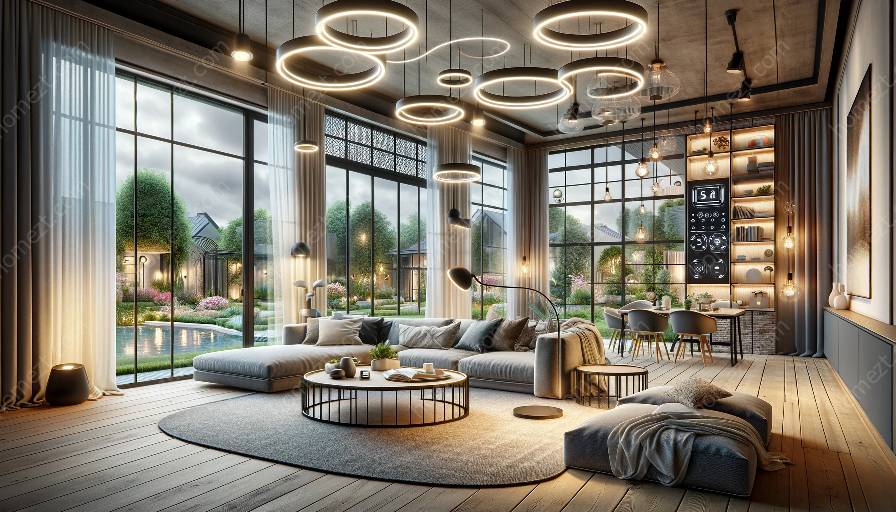Smart LED lights have revolutionized the way we light up our homes. From energy efficiency to convenience and aesthetics, these advanced lighting solutions have become an integral part of intelligent home design. In this comprehensive guide, we will delve into the features and uses of smart LED lights, exploring how they fit into smart lighting solutions and enhance the overall design of a modern home.
Understanding Smart LED Lights
Smart LED lights are lighting fixtures that incorporate advanced technology to offer a range of intelligent features. These lights are connected to a network, such as Wi-Fi or Bluetooth, allowing them to be controlled remotely through various devices, such as smartphones, smart speakers, or dedicated home automation systems.
Key Features
- Energy Efficiency: One of the standout features of smart LED lights is their energy efficiency. These lights use less energy compared to traditional incandescent or fluorescent bulbs, resulting in cost savings and reduced environmental impact.
- Customizable Lighting: Smart LED lights often come with color-changing capabilities, allowing users to adjust the color temperature and brightness to create the desired ambiance in any room.
- Remote Control: With the help of dedicated apps or voice assistants, users can remotely control their smart LED lights, adjusting settings, scheduling lighting routines, and even integrating them with other smart home devices.
- Motion and Presence Detection: Some smart LED lights are equipped with motion and presence sensors, automatically turning on or adjusting the lighting levels when someone enters a room, offering convenience and safety benefits.
- Integration with Smart Home Ecosystems: Smart LED lights seamlessly integrate with popular smart home platforms, such as Apple HomeKit, Google Home, and Amazon Alexa, allowing users to create cohesive smart lighting solutions within their homes.
- Health and Well-being: Certain smart LED lights offer features such as circadian rhythm support, mimicking natural lighting patterns to promote better sleep and overall well-being.
Uses in Intelligent Home Design
Smart LED lights have a wide range of applications within intelligent home design, offering numerous benefits that cater to both aesthetics and functionality.
Enhanced Ambiance
One of the primary uses of smart LED lights is to enhance the ambiance of living spaces. With customizable color options and brightness settings, these lights can transform the mood of a room, whether it's for a relaxing evening at home or a vibrant social gathering.
Energy Management
Integrating smart LED lights into a home's lighting design enables efficient energy management. By scheduling lighting routines and using motion sensors, homeowners can optimize energy consumption and reduce electricity costs over time.
Security and Safety
Smart LED lights play a vital role in enhancing home security and safety. Automated lighting can create the illusion of occupancy when homeowners are away, deterring potential intruders. Motion-activated lights also provide added safety by illuminating pathways and entry points.
Personalized Lighting Experiences
Individuals can personalize their lighting experiences with smart LED lights, adapting the ambiance to match their activities and preferences. Whether it's setting the perfect lighting for reading, cooking, or unwinding after a long day, these lights offer tailored solutions for every occasion.
Integration with Smart Lighting Solutions
Smart LED lights form an integral part of comprehensive smart lighting solutions, which aim to provide seamless control and management of lighting throughout a home.
Centralized Control
Smart lighting solutions centralize the control of all lighting fixtures, allowing users to manage them from a single interface. This provides convenience and simplifies the process of adjusting lighting settings across different rooms and areas of the home.
Automated Scheduling
By integrating smart LED lights into smart lighting solutions, homeowners can schedule lighting routines based on their daily activities or preferences. This automation not only enhances convenience but also contributes to energy efficiency.
Integration with Other Smart Devices
Smart LED lights seamlessly integrate with other smart devices and sensors within a home. This interconnected ecosystem allows for advanced automation, such as triggering lights based on motion detection, or coordinating lighting with music and multimedia experiences.
Conclusion
Smart LED lights offer a multitude of features and uses that align perfectly with intelligent home design and smart lighting solutions. With their energy efficiency, customization options, and seamless integration, these lights have the potential to transform the way we illuminate and interact with our living spaces. Embracing smart LED lights can lead to a more sustainable, comfortable, and secure home environment, representing a significant step forward in modern home design and technology.


